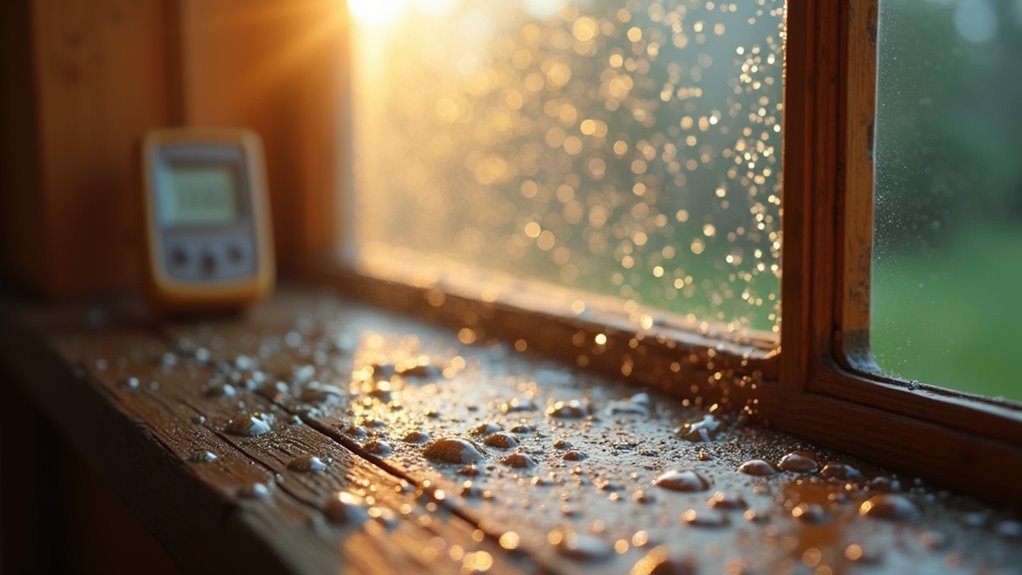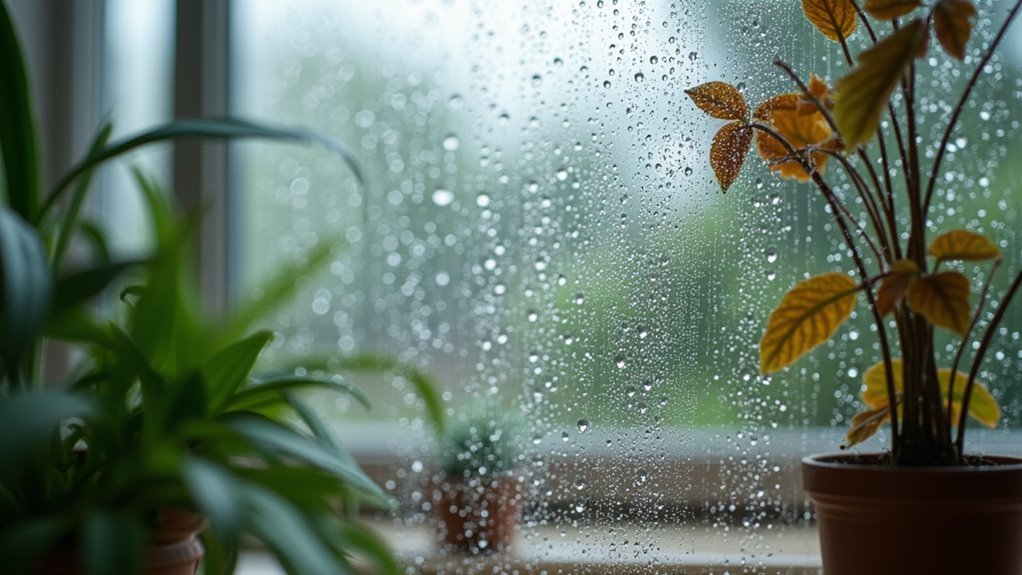You’ve probably noticed how stuffy your home feels on humid summer days or how dry your throat gets during winter months, but you might not realize these comfort issues signal something more serious about your indoor air quality. The moisture level in your home doesn’t just affect how comfortable you feel—it’s actively changing the concentration of pollutants you’re breathing and determining which harmful microorganisms can survive in your living space.
The Relationship Between Moisture Levels and Indoor Air Pollutants

Moisture acts as a catalyst for indoor air pollution, directly influencing the concentration and behavior of harmful substances in your home.
When humidity levels rise above 50%, you’ll notice increased off-gassing of volatile organic compounds (VOCs) from furniture, carpets, and building materials. These elevated moisture levels also create perfect breeding grounds for biological pollutants like mold, bacteria, and dust mites.
Chemical interactions between indoor air pollutants intensify considerably when relative humidity reaches 30% and worsen as levels climb higher.
You’re facing greater exposure to irritating odors, chemical contaminants, and ozone. This combination can trigger allergic reactions, respiratory issues, and other health problems.
Controlling your indoor moisture effectively reduces pollutant concentrations and creates a healthier living environment.
How High Humidity Increases Chemical Contaminant Concentrations
When humidity climbs above 50% in your home, you’ll experience dramatically increased off-gassing of volatile organic compounds from everyday items like furniture, carpets, and paint.
High humidity levels accelerate these off-gassing rates, causing harmful chemicals to leach into your breathing space more rapidly than normal conditions allow.
Moisture in the air doesn’t just increase existing chemical pollutants—humidity can cause new reactions that create additional contaminants you weren’t dealing with before.
Your indoor air quality deteriorates as formaldehyde, benzene, and other volatile organic compounds (VOCs) concentrate at higher levels.
These chemical interactions intensify around 30% relative humidity and become markedly worse beyond 50%, creating a compounding effect that continuously degrades your home’s air quality and potentially impacts your health.
Low Humidity’s Impact on Airborne Virus Survival

While high humidity creates problems with chemical contaminants, low humidity presents an entirely different threat to your indoor air quality by greatly increasing airborne virus survival rates.
When your indoor humidity drops below 40% relative humidity, you’re creating ideal conditions for viruses like influenza to thrive and spread throughout your space.
Low humidity doesn’t just help airborne viruses survive longer – it also weakens your body’s natural defenses against these pathogens.
Dry air causes your respiratory tract’s mucous membranes to become dehydrated, impairing their ability to trap and eliminate viral particles before they can cause respiratory infections.
You can notably reduce virus survival rates and protect against health issues by maintaining indoor humidity levels above 40% relative humidity.
Understanding Relative Vs Absolute Humidity in Your Home
How can you effectively manage your home’s humidity when the numbers seem to change constantly throughout the day? Understanding relative humidity versus absolute humidity is key to maintaining ideal indoor air quality.
Relative humidity measures water vapor as a percentage of air’s maximum capacity at current temperature. When temperature rises, relative humidity drops even if actual moisture levels stay constant. Absolute humidity measures the actual mass of water vapor present, regardless of temperature changes.
| Measurement Type | Temperature Impact | Best Use |
|---|---|---|
| Relative Humidity | Changes with temp | Daily comfort monitoring |
| Absolute Humidity | Stays constant | Tracking actual moisture |
| Combined Reading | thorough view | Health and comfort optimization |
Monitoring both prevents mold growth, reduces pollutant concentrations, and guarantees your home stays within the healthy 40-60% range.
Why Humidity Affects VOC Emission Rates From Building Materials

Most homeowners don’t realize that their carefully chosen low-VOC paints and finishes can actually release considerably more harmful compounds when humidity levels climb above the recommended range.
When relative humidity exceeds 60%, materials like wood, adhesives, and paints increase their emission rates dramatically. Research shows volatile organic compounds (VOCs) can surge by up to 50% in high-humidity conditions, flooding your space with indoor air pollutants like formaldehyde.
High moisture doesn’t just accelerate emissions—it triggers chemical reactions that create entirely new pollutants.
You’ll maintain ideal humidity between 40-60% relative humidity to minimize these effects. By controlling moisture levels, you’re directly reducing VOC off-gassing from building materials and creating a healthier indoor environment for your family.
The Connection Between Moisture and Biological Pollutant Growth
Beyond the chemical emissions from your building materials, moisture creates an entirely different threat to your indoor air quality: biological pollutants.
When humidity levels exceed 50%, you’re creating prime conditions for mold growth, dust mites, and bacteria to thrive in your home. These biological pollutants release allergens that can trigger respiratory issues and allergic reactions.
You’ll want to maintain humidity levels between 40-50% to minimize these health risks.
Notably, different pollutants prefer different moisture conditions—influenza viruses actually thrive below 50% humidity, while mold and dust mites flourish above this threshold.
Optimal Humidity Ranges for Healthier Indoor Environments
Finding the sweet spot for indoor humidity requires maintaining levels between 40-60% relative humidity, where your health and comfort intersect with ideal air quality.
These ideal humidity levels create an environment that minimizes allergens while supporting your respiratory system’s natural defenses against infections.
Managing moisture levels within this range delivers multiple benefits:
- Reduces pathogen spread – Humidity above 40% greatly decreases respiratory infections and airborne illness transmission
- Controls allergen growth – Prevents excessive biological pollutant development that thrives in extreme conditions
- Minimizes VOC exposure – Keeps Volatile Organic Compounds from off-gassing at dangerous levels above 70% humidity
- Maintains respiratory health – Prevents the dryness and irritation that occurs below 30% humidity
Consistently monitoring your indoor air quality guarantees you’ll maintain this essential balance for healthier living.
How Humidity Influences Dust Mite and Allergen Levels
Dust mites represent one of the most problematic allergen sources in your home, and they’re directly tied to your indoor humidity levels.
Your home’s humidity levels directly determine how aggressively dust mites multiply and spread allergens throughout your living spaces.
These microscopic creatures thrive when relative humidity exceeds 50%, rapidly multiplying and producing allergens that trigger respiratory problems. You’ll notice significant improvements in your indoor air quality when you maintain humidity between 40-60%. At these levels, dust mites struggle to survive and reproduce effectively.
High humidity doesn’t just support dust mites—it also promotes mold and bacteria growth, compounding your allergy issues.
You can control these conditions by using dehumidifiers and ensuring proper ventilation throughout your home. Regular monitoring with a hygrometer helps you maintain ideal levels, protecting your respiratory health while dramatically reducing allergen concentrations in your living spaces.
Smart Sensors for Monitoring Home Humidity and Air Quality
You can now leverage smart sensor technology to continuously track your home’s humidity levels and air quality with unprecedented precision.
These advanced devices provide real-time data that alerts you when conditions drift outside the ideal 40-60% humidity range, helping you maintain healthier indoor environments.
When integrated with your smart home system, these sensors can automatically adjust your HVAC equipment and provide historical data to guide your long-term air quality decisions.
Sensor Technology Overview
When it comes to maintaining ideal indoor air quality, smart sensors have revolutionized how you can monitor and manage humidity levels in your home.
These advanced devices use sophisticated algorithms to continuously track real-time data, detecting fluctuations in humidity and air pollutants that could compromise your indoor environment.
Modern smart sensors offer extensive monitoring capabilities:
- Optimal range maintenance – Keep humidity levels between 40-60% for maximum health and comfort
- Multi-parameter tracking – Monitor VOC levels, particulate matter, and other air quality indicators
- Historical data analysis – Identify patterns to make informed humidity management decisions
- Home automation integration – Automatically adjust dehumidifiers and HVAC systems based on readings
You’ll receive instant alerts when conditions change, allowing you to take immediate action to protect your indoor air quality.
Real-Time Data Benefits
Smart sensors transform passive monitoring into active environmental management by delivering instant, actionable data about your home’s humidity and air quality conditions.
You’ll receive continuous updates on humidity levels, enabling immediate responses when readings exceed the ideal 40-60% RH range. This real-time data helps you identify pollutants and allergens before they compromise your indoor air quality.
When humidity fluctuates unexpectedly, you can address moisture control issues promptly, preventing mold growth and VOC accumulation.
Smart sensors reveal patterns that would otherwise go unnoticed, showing how daily activities and seasonal changes affect your environment.
Smart Home Integration
Beyond standalone monitoring, modern humidity sensors seamlessly connect with your existing smart home ecosystem to create a fully integrated environmental control system.
These smart home systems enable automated adjustments that respond instantly to changing humidity levels, maintaining your indoor environment within ideal 40-60% RH ranges.
Air quality sensors work alongside humidity monitors to provide thorough real-time monitoring of your home’s conditions. When humidity thresholds are exceeded, your system automatically activates dehumidifiers or humidifiers without requiring manual intervention.
Key integration capabilities include:
- Automated climate control activation based on sensor readings
- Mobile app access for remote monitoring and control
- Historical data tracking for pattern identification
- Multi-room coordination for whole-home humidity management
This intelligent automation guarantees consistent air quality while reducing the guesswork in maintaining healthy humidity levels.
Seasonal Humidity Management Strategies for Better Air Quality
Since humidity needs vary dramatically between seasons, you’ll need different strategies to maintain perfect indoor air quality year-round.
During summer, use dehumidifiers while keeping windows closed to prevent moisture entry, making sure humidity levels stay within 40-60% RH.
Summer humidity control requires dehumidifiers and closed windows to maintain optimal 40-60% relative humidity levels indoors.
In winter, employ heat recovery ventilators to bring in fresh air while managing humidity and preventing overly dry conditions.
Regular monitoring with a hygrometer helps maintain ideal 30-50% humidity levels, which minimizes pollutants and guarantees comfort.
Your ventilation systems should include dehumidifiers in humid climates to reduce mold and biological pollutants effectively.
During dry, hot weather, increase ventilation by allowing fresh air indoors during evenings—this dilutes indoor pollutants while maintaining healthier humidity levels for better seasonal humidity management.
Common Humidity Control Mistakes That Worsen Indoor Air
While maintaining proper humidity levels is essential for healthy indoor air, many homeowners make significant mistakes that actually worsen their air quality.
These common errors can turn your humidity control efforts into counterproductive measures that increase pollutants and health risks:
- Relying solely on dehumidifiers without fixing underlying issues like leaks or poor ventilation that cause excess moisture
- Ignoring seasonal adjustments to humidity control systems, allowing summer’s higher levels to promote mold growth and pollutant concentration
- Failing to monitor humidity levels regularly, missing the ideal 40-60% range that prevents discomfort and health problems
- Neglecting air conditioning maintenance with dirty filters and coils that impede airflow and reduce humidity control effectiveness
Proper ventilation remains vital for preventing moisture buildup and maintaining the best indoor air quality year-round.
DIY Solutions for Balancing Moisture and Air Quality
Fortunately, you can implement several effective DIY solutions to balance moisture and air quality without costly professional interventions.
Start by installing a hygrometer to monitor humidity levels consistently, targeting the ideal 40-60% range for your indoor spaces. When levels exceed this range, use a dehumidifier to remove excess moisture and prevent mold growth.
Improve ventilation by running exhaust fans in kitchens and bathrooms during and after moisture-generating activities. These fans expel humid air before it spreads throughout your home.
Additionally, strategically place houseplants like peace lilies or Boston ferns that naturally absorb moisture while filtering pollutants from the air.
Regular monitoring and these simple adjustments will greatly enhance your indoor air quality.
When to Use Humidifiers Vs Dehumidifiers for Air Quality
Although monitoring humidity helps you identify moisture imbalances, choosing the right equipment to correct them requires understanding when each device works best.
Your humidity levels determine which device will improve indoor air quality most effectively.
Selecting the appropriate humidity control device depends entirely on your current indoor moisture levels and specific air quality goals.
Use humidifiers when:
- Relative humidity drops below 30%, causing respiratory issues and dry skin
- Winter air becomes excessively dry, increasing virus susceptibility
- You’re experiencing discomfort from parched indoor conditions
- Low moisture levels threaten your health and comfort
Deploy dehumidifiers when:
- Humidity exceeds 60%, promoting mold growth and dust mites
- Summer brings excessive moisture that worsens allergies
- High humidity increases volatile organic compounds (VOCs) emission from materials
- You need to prevent air quality degradation from excess moisture
Maintaining 40-60% relative humidity optimizes your indoor environment year-round.
Long-Term Health Effects of Poor Humidity Control
Poor humidity control creates a cascade of health problems that compound over years of exposure. When you’re exposed to consistently high humidity levels, you’ll face increased mold growth that releases allergens and volatile organic compounds (VOCs) into your air.
These contaminants trigger chronic respiratory issues including persistent asthma symptoms, allergies, and frequent infections. Poor humidity control below 30% weakens your immune system by allowing airborne viruses to spread more easily, leading to recurring illnesses.
Over time, you’ll experience escalating health complications like chronic headaches, dizziness, and breathing difficulties from VOC exposure.
The long-term health effects extend beyond immediate discomfort—prolonged exposure to poorly controlled environments can permanently damage your respiratory system and overall well-being, creating lasting health burdens that affect your quality of life.
Frequently Asked Questions
Does Humidity Affect Indoor Air Quality?
Yes, humidity directly affects your indoor air quality. When you maintain levels between 40-60%, you’ll reduce mold, dust mites, and VOC emissions. Higher humidity promotes pollutant growth and chemical reactions that worsen air quality.
What Are the Symptoms of Humidity Sickness?
You’ll experience respiratory issues like coughing and wheezing, skin irritations, headaches, and increased fatigue. High humidity can trigger asthma attacks, cause dizziness from heat stress, and worsen allergy symptoms considerably.
Will Mold Grow at 55 Humidity?
You’re generally safe from mold growth at 55% humidity, though some mold can survive. For ideal protection, you’ll want to maintain humidity between 40-50% to prevent mold proliferation completely.
Is 70% Humidity Inside Too High?
Yes, 70% humidity inside is too high. You’ll risk mold growth, poor air quality, and structural damage. You should maintain humidity between 40-60% for ideal comfort and health in your home.





Leave a Reply